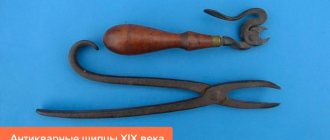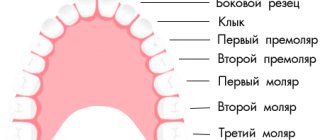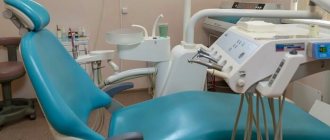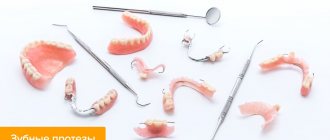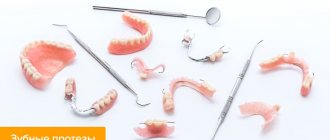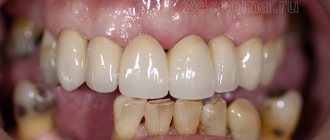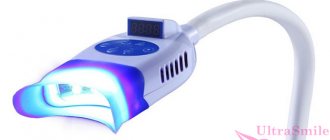- Complete removable dentures in Moscow
- Indications for use
- Types of removable dentures in complete absence of teeth
- Plate dentures for the entire jaw
- Removable dentures made of soft plastic
- Acrylic dentures for all teeth
- Removable nylon dentures
- Complete removable silicone dentures
- Clasp dentures for the entire jaw
- Pros and cons of complete dentures
- Preparation for prosthetics
- Manufacturing of complete removable dentures
- Fixation
- Care of complete dentures
- Complete removable dentures price
If we look at official statistics, almost half of the residents of our country by the age of 65 are faced with the problem of complete loss of teeth. In medical practice, this phenomenon is called adentia. This situation should not be ignored, since edentia is not just an aesthetic defect that can cause psychological discomfort in the patient and affect self-esteem. Losing teeth is dangerous because it triggers a series of more serious health problems: the process of grinding food worsens, which leads to dysfunction of the digestive organs, impairs intestinal function, and as a result, the functioning of all internal organs is disrupted.
The most progressive methods of restoring lost teeth are prosthetics on implants or the use of removable structures. Despite all the visible advantages of implantation, this method also has significant disadvantages. It may not be suitable for patients because it requires surgery, which may be contraindicated. And the second significant point is the high cost of all manipulations. An alternative, universal and suitable method of prosthetics for completely edentulous patients is the production and installation of removable orthopedic dental structures.
Removable dentures are distinguished by the fact that they can be removed and put on independently, at any time, without the involvement of specialists. There are two types of these structures:
- partially removable dentures;
- complete removable dentures.
Indications for use
As a rule, complete removable dentures are indicated for defects in a number of teeth, such as complete loss of chewing teeth. In addition, the pathological condition of the periodontium may be an indication. Severe periodontitis requires the installation of such structures; this will be the best solution for patients with this disease. The choice of the type of prosthesis depends on the specific case; the decision is made by the doctor together with the patient, based on a thorough examination of the oral cavity.
False upper jaw and false lower jaw: what are the differences?
If we are talking about clasp dentures or a removable jaw on implants, then the differences are small - except perhaps the shape of the frame and artificial teeth. If the patient is fitted with a classic complete denture, the upper denture has an artificial palate with suction cups, which helps fix it in the oral cavity. Some people believe that the upper artificial jaw holds up worse than the lower one, but this is not true. The lower jaw does not have such a large area of mucous membrane: the prosthesis is fixed using suction cups and a special cream, but still the risk of prolapse in the lower false jaw is much higher.
Types of removable dentures in complete absence of teeth
If there are no teeth left, the choice of design is significantly limited. Modern medicine offers the installation of prostheses on implants - this is the most reliable and most aesthetic method, but it is not available to everyone due to its high cost and indications. In this case, plate dentures remain - they are suitable for people of any age, if there are no allergic manifestations to the material used to create them. In the absence of teeth, all structures are similar in structure, but can be made of different materials. Let's decide what the pros and cons of different options are.
Plate dentures
Plate dentures, as the name implies, are a plate of different sizes. It acts as the basis of the structure, its basis. Fixing elements and artificial teeth are attached to it. Previously, such dentures were made exclusively from hard materials, but today dental technicians have a wider choice. This allows you to select products individually for patients, based on their needs and financial capabilities. But here it is necessary to remember that the material affects not only the comfort of wearing a denture, but also its service life.
Soft plastic dentures
Thus, acrylic products are considered the most durable. But since they are not always comfortable to wear, the formula of the material has been refined and improved. Complete removable dentures made of soft plastic were born. They are a combination of acrylic with the addition of additional components (for example, diamond chips). Their service life is very impressive, but due to their more plastic structure, they do not injure the gums, do not rub, and provide a tight fit.
Acrylic dentures
This type of prosthesis is the most popular - it is characterized by low price, aesthetics and ease of use. It consists of a base that covers the alveolar process and the body of the jaw, and artificial teeth attached to it. Before installing such a prosthesis, as in other cases, the oral cavity is first prepared for prosthetics, loose teeth are removed and the mucous membrane is treated, and then an impression of the jaws is made. Based on the impression, a primary model is created in the laboratory, which is adjusted and corrected after fitting. Acrylic or plastic prosthesis has the following advantages:
- an affordable way to completely restore teeth;
- ease of use;
- durability (7-9 years with proper care);
- uniform distribution of chewing load;
- quick adaptation period;
- lightness of the material, comfort of use;
- aesthetics and the ability to create a prosthesis that perfectly matches the color of natural gums;
- possibility of repair and correction;
- quick installation.
However, in order to decide which prosthesis is best to choose, you should know not only the advantages, but also the disadvantages of each type of design. For acrylic dentures, this is the possibility of an allergic reaction to the material, trauma to soft tissues during use, bad breath (acrylic is a porous material, bacteria can multiply in it), partial loss of taste, increased gag reflex, temporary impairment of diction and frequent need for correction. Most of these negative effects go away as you get used to the prosthesis, but some you have to put up with. To complete the adaptation period as quickly as possible, do not remove the denture at night.
Nylon dentures
The products are made from pink nylon, which is elastic and durable. They are similar to plate acrylic dentures, but differ from them in some parameters. This design perfectly imitates the gum and part of the alveolar process, it holds well and is suitable for sports enthusiasts. Such dentures are not removed at night even after the end of the adjustment period. A nylon prosthesis has the following advantages:
- hypoallergenic;
- high aesthetics;
- reliable fixation;
- low porosity, and, as a result, the absence of bad breath even after long-term use;
- flexibility, elasticity, comfortable use;
- durability (about 5 years);
- rare percentage of breakdowns.
The disadvantages of this type include the need for care of the prosthesis with the help of special means, the inability to repair in case of breakage, possible bone atrophy and mucosal injuries with prolonged use, uneven distribution of the chewing load (the flexible frame prevents this), the need for frequent correction and relatively high price.
In case of complete absence of teeth, implants are used to better fix the structure, and a metal arch is often used, which enhances the strength of the base. Thus, nyl dentures resemble dentures with a metal base and become even more durable.
Silicone prostheses
They are similar to nylon, but very different from them. Silicone is translucent; artificial – most often plastic – teeth are attached to a base made of it. Silicone dentures, as a rule, are used as temporary ones, because large gaps form between the teeth over time, and the service life of the structure is no more than two years, and it is rarely used for complete dentures. Their advantages:
- natural appearance;
- no allergic reaction;
- lightness and compactness;
- good fixation;
- softness of the material.
With prolonged use of the structure, atrophy of the alveolar bone and subsidence of the gums are possible, which is its significant drawback. In addition, they provide poor distribution of the chewing load and are difficult to maintain.
Clasp dentures
Clasp-type structures are practically not used in cases of complete edentia, since for strong fixation it will be necessary to create supporting surfaces. This requires additional time and financial expenses.
Pain after prosthetics
After installation of the orthopedic structure, the patient may experience pain. They are mainly caused by either adaptation of oral tissues to the elements of the prosthesis, or the development of inflammatory processes. Pain due to adaptation goes away on its own or after correction of the structure.
But pain after dental prosthetics, caused by inflammation, is fraught with dangerous consequences, so if they last longer than a few days, do not subside, but intensify, are accompanied by an unpleasant odor, the discharge of pus, it is urgent, without delay, to consult a doctor.
The cause of pain may be untreated foci of infection in the oral cavity, infection as a result of errors in the installation of the structure or previous preparatory operations, violation of the rules for using the prosthesis and oral hygiene, allergic reactions to the materials used in dental prosthetics, as well as too tight, or, conversely, , insufficiently tight fit of the prosthesis to the soft tissues.
In order to identify the causes of inflammation and cure it, it is necessary to contact a dental clinic, otherwise this can lead to breakage of the prosthesis, rejection of its structural elements and serious complications.
Pros and cons of complete dentures
Such designs are very popular; they have many advantages, including:
- Strength and elasticity . Prostheses are comfortable to wear, suitable for patients of all ages and safe. They are made according to an individual impression.
- High aesthetics . It is possible to choose the shape and color of teeth and gums as close as possible to natural ones. All this is selected on an individual basis.
- Easy to care for . Such structures are easy to care for; sometimes you just need to rinse them in running water.
The disadvantages include the following features:
- relatively long adaptation period;
- insufficiently stable fastening;
- feeling of discomfort when laughing, coughing or eating;
- not very long service life;
- food restrictions;
- violation of speech functions;
- the need for preventive regular examinations by a doctor.
What material is it made from?
The most important characteristics of removable structures, such as secure fixation, wearing comfort and aesthetics, are determined by the materials from which these structures are made.
Plastic
Acrylic plastic is used to make plastic dentures. This option can be used for both complete and partial edentia.
The prosthesis is secured using the “suction effect”. The patient bites down on the denture, excess air comes out of it, and a tight fit to the gum is ensured.
Acrylic
The most popular and affordable dentures are acrylic. Used to restore partially lost teeth.
Pros:
- low cost;
- ease of manufacture and operation;
- good aesthetics - acrylic does not change its properties over time, and is not stained by coffee, tea or cigarettes.
Reviews of acrylic dentures are generally good, except for the possibility of allergies, which is why some patients remove them at night.
The photo shows an acrylic prosthesis
Nylon
Soft dentures are made from elastic nylon. They can be used for both partial and complete absence of teeth.
The positive aspects of nylon prostheses are:
- good level of elasticity;
- they are thinner and lighter compared to other materials;
- high flexibility.
These properties increase wearing comfort. However, this material has more negative aspects than positive ones. Firstly, the healing of the structure: due to the soft elastic nylon, the gums are greatly deformed, so bone resorption may even occur. Secondly, chewing food is often accompanied by pain. Finally, nylon dentures have to be adjusted frequently.
The photo shows a nylon prosthesis
Аcryfree
Acri-free - modern nylon prostheses. This material was first developed by an Israeli company. They occupy an intermediate position between plastic and nylon structures, incorporating their best qualities. Such structures are made from advanced acrylic plastic. They have a slightly greater degree of flexibility than acrylic ones.
Among the advantages they note:
- high aesthetic properties;
- wearing comfort;
- almost invisible thanks to the translucent material.
The photo shows an AcryFree nylon prosthesis
Spofadent
A new version of dentures, which includes three-layer plastic, which gives Spofadent dentures high strength. The material shows high aesthetic properties: it can be easily painted in various shades of pink and white. Dentures made from Spofadent are practically not exposed to chemicals contained in soda, drinks and food. Like Acryfree, this material is translucent, so it is excellent for prosthetics of front teeth.
Ivobase
It is an organic thermoplastic material, the chemical name of which is polymethyl methacrylate. The manufacturing technology of this material itself makes it possible to reduce allergic reactions and eliminate errors when installing dentures (overbite or excessive shrinkage).
Moreover, structures made from Ivobase have increased strength and low porosity, so the material is not stained by pigments contained in food and is slightly susceptible to bacterial attack. Such prostheses have high biocompatibility, quality and wearing comfort.
Vertex
Vertex is a modern thermoplastic material that is manufactured without the use of monomers, which ensures the absence of allergies, burning and itching when worn. Patients do not experience a feeling of dryness, articulation and taste perception are not impaired when using prostheses from Vertex. This material is stronger than other plastic structures, so manufacturers can make the base as thin as possible. You can choose shades of white and pink for each specific occasion. The material has good properties and is therefore suitable for full and partial prosthetics.
The photo shows the Vertex prosthesis
Deflex
The material comes from Argentina. It contains modern innovative thermoplastic polyamide. The base of such dentures is made completely transparent, and if desired, you can give it a pink tint. Such dentures are more flexible and durable than acrylic structures. They are recommended for police officers, firefighters, boxing athletes and other people with traumatic professions. However, this material has several disadvantages:
- ability to absorb odors;
- inability to repair the prosthesis.
Deflex is recommended for use only for partial dentures. However, if other teeth are lost, the entire prosthesis will have to be redone.
The photo shows the Deflex prosthesis
Preparation for prosthetics
An important role in the manufacture of high-quality, comfortable designs is played by preparing the patient for prosthetics. The doctor conducts a detailed examination of the oral cavity, identifies individual structural features of the maxillofacial apparatus, and determines the characteristic features of the jaws. At this stage, the material for creating the future structure, the optimal shape, size and color of artificial teeth are selected.
Individual spoons are used. The composition of the mass for impressions is also selected personally. Based on the casts, a model of the jaws is made.
The finished product is made from wax or plaster models. This is quite painstaking work and is carried out using special equipment. In this case, it is important to clearly maintain the distance between the teeth, the depth of their fixation, inclination and many other parameters.
When trying on dentures, the dentist identifies possible nuances that prevent a tight fit. All comments are sent to the laboratory, where a dental technician adjusts the design.
Are partial dentures repairable?
During use, individual parts of the prosthesis may break off. Under no circumstances should you attempt to repair it yourself; it is better to contact a specialist. If the situation can be corrected, it will only take a couple of days to fix it.
Every six months to a year, during a scheduled visit to the dentist, it is necessary to reline the plate and clasp structures, since the contour of the gums and the level of bone tissue change over time. The adjustment improves fit and load distribution, resulting in the product not chafing or breaking.
Manufacturing of complete removable dentures
The manufacturing process of both acrylic and nylon removable dentures occurs in several stages: taking impressions of the gums, casting a plate, welding teeth to it, and fitting the dentures to the patient’s jaws.
Acrylic dentures are produced by injection molding, and nylon ones are produced by hot injection under pressure. The latter method requires expensive modern equipment and qualified specialists who can work with such equipment. This has an impact on cost, and therefore nylon dentures are much more expensive than acrylic ones.
Which implants to choose?
Today there are more than 3,000 implant systems in the world. However, not all of them can boast a long history of observations and clinical trials around the world. There are also some implant systems that, despite their reliability, are not very common in Russia. This may lead to difficulties in terms of delivery of original components of implant systems.
It is worth choosing only generally recognized implant systems, which are used by different doctors independent of each other. Otherwise, the patient risks finding himself in a situation where no one can help him.
An important point when choosing an implant system is the type of implant-abutment connection. It determines how long the implant will last. The most reliable today is the conical implant-abutment connection with the effect of switching platforms. It is able to withstand greater loads compared to a flat connection, is leak-tight and does not cause resorption of bone tissue around the implant.
The healing of implants is affected by the purity of the titanium from which they are made. The most common is Grade 4 - commercially pure titanium. Grade 1,2,3 alloys are even purer. Grade 5 – less pure, contains impurities of vanadium and aluminum.
The surface of each implant is a unique patented technology, because... It is on the surface of the implant that osseointegration occurs—the fusion of the implant with the bone tissue. Serious implant manufacturing companies conduct a lot of research, proving that their implants are integrated not only in standard situations, but also, for example, in people suffering from diabetes or bleeding disorders. The following systems meet all these requirements: Straumann (Switzerland), Ankylos (Germany), Astra tech (Sweden), Nobel biocare (USA/Sweden). Among the inexpensive systems, we can highlight Osstem implants (South Korea). They have proven themselves throughout the world as a reliable and economical implant system.
Care and storage
Dentures must be periodically removed from the mouth and cleaned. It's great if you do this every time after eating, but if this is not possible, you can rinse them in the morning and evening. Full dentures can be left in your mouth overnight, but it is best to remove them to give your gums a rest. In this case, before putting it in a special box, you need to thoroughly clean the prosthesis - rinse with boiled water, treat with an antiseptic solution or brush. It is recommended to have it professionally cleaned twice a year.
There is an opinion that the prosthesis should be stored in water or in a special solution. This is not so - a similar method was suitable for rubber prostheses, but modern technologies have made it possible to move away from it. Now it is enough to wrap the prosthesis in a cotton cloth and put it in a special box, where it will be protected from the sun, mechanical damage, heat and chemical influences.
How a partial denture is attached to the jaw
There are 3 options for fastening removable structures: hooks (clasps), locks (attachments), telescopic crowns.
We propose to consider each of the options in more detail. Clasps. They are hooks made of metal or plastic that grip healthy teeth and fix the orthopedic structure in the mouth. The disadvantage of such fastening is poor fixation and unsatisfactory aesthetics. Despite the fact that the hooks are covered by the lip, they are visible to others when smiling and talking.
Attachments. More preferable from an aesthetic point of view. The special lock consists of 2 parts. One element is built into the base of the prosthesis, and the other is attached to the crown that covers your own tooth. This fastening option has a more reliable fixation and gives the product stability. In addition, the attachments distribute the chewing load more evenly, which slows down bone atrophy by almost 2 times.
Telescopic crowns. Presented by a system consisting of 2 crowns. The inner one follows the contours of the ground tooth. The outer one is connected to the base and restores the shape of the tooth. This allows the prosthesis to be securely fixed and prevents it from moving. The possibility of installing a telescopic structure in each specific case is determined by the doctor, since grinding of a large layer of hard tissue of the supporting tooth is required.
Cost of complete removable dentures
| Name | Price from |
| Consultation with a specialist (included in the manufacturing cost when ordering a prosthesis) | 500 rub. |
| Cost of complete removable dentures for both jaws | 60,000 rub. |
The cost of services is determined individually for each patient, since the individual characteristics of the patient’s oral cavity play a key role in the manufacture of structures. Factors such as the anatomical structure of the maxillofacial apparatus, the chosen type of structure, the material of its manufacture and methods of fixation, the shape and color of artificial teeth are taken into account.
Denta Labor dental laboratory produces complete removable dentures of excellent quality. Our laboratory has created all the conditions to produce high-quality prostheses with a long service life. You can check prices for removable dentures by phone +7 (495) 162-08-25.
Promotion! When paying in advance the full cost of making the prosthesis, the cost is reduced by 2000.
Lifespan of removable partial dentures
Practice shows that the service life of removable plate structures is on average 3-5 years, after which the structure has to be changed. Bugel products have a longer lifespan - up to 5-7 years.
In general, the duration of wearing depends on several factors:
— the quality of the design and the professionalism of the specialist who carried out the installation;
— characteristics of the body and the condition of the oral cavity, the presence of gum diseases and deformation of the dentition;
— accuracy of compliance with doctor’s recommendations and proper home care.
How much will it cost on average in Moscow?
The cost of implantation in different clinics is determined individually, taking into account:
- volume of planned work;
- materials used, medications;
- diagnostic procedures;
- the patient's wishes regarding aesthetics.
Let's give the average cost of dental implantation services in Moscow clinics.
| Name of service | Cost, rub. |
| Temporary crown | 4000 |
| Installation of the healing abutment | 5000 |
| Custom abutment | 7500 |
| Implantation, without implant cost | 22000 |
| Removable denture locator | 25000 |
| Turnkey implantation of one tooth using a two-stage method | |
| With metal-ceramic crown | 39100 |
| With all-ceramic crown | 50200 |
| Express implantation with metal-ceramic crown | 58000 |
| With a ceramic crown on a special alloy | 60000 |
| Full dental implantation for edentulous jaws | |
| Prosthetics on 4 implants according to the “All-on-4” protocol | 350000 |
| Prosthetics on 6 implants according to the “All-on-6” protocol | 450000 |
| Installation of 14 implants on the jaw, with bone grafting and prosthetics | 900000 |
Advantages
Partial dentures are a quick and affordable way to restore teeth without surgery.
- Cost They are much cheaper than implantation and do not require expensive surgical procedures or osteoplastic surgery.
- Speed: Production takes 1-2 weeks. For implantation with preparation, bone grafting and engraftment of implants - at least 4 months.
- Convenient When properly made from high-quality materials, taking into account the bite after adaptation, it feels like your own teeth in the mouth.
- Aesthetics Improved materials and modern orthopedic protocols make it possible to create prosthetics that are indistinguishable from natural teeth.
When using removable prosthetics, it is extremely important that the prosthesis is made not “by eye,” but taking into account the characteristics of the patient’s dentofacial apparatus. Otherwise, it is impossible to obtain a comfortable denture with the correct distribution of chewing load. This is fraught with constant inconvenience, gum injuries, rapid destruction of supporting teeth, the formation of a pathological bite, and dysfunction of the jaw joint.
Chashchin Kirill Valerievich
Orthopedic dentist, 14 years of experience
Digital prosthetics. Aesthetic restorations with veneers with a lifetime guarantee. Total orthopedic rehabilitation in one day
More about the doctor
Why is it necessary to build up bone tissue and do a sinus lift?
Often with edentia there is a lack of bone mass. The longer the space in the jaw is empty without proper load, the more active the atrophic processes are. Volume can be restored through bone grafting. This is an effective procedure aimed at creating a reliable foundation for a titanium rod. It is indicated for:
- bone atrophy;
- loss of tissue due to periodontitis (inflammatory process of the structures that support the tooth);
- deterioration of bone condition after injury.
More often the problem occurs in the upper jaw. This is due to the peculiarities of the anatomical structure. A significant part of the bone in the upper row is the maxillary sinus. The sinus lift technique allows you to restore the missing volume. The procedure is carried out if:
- bone structures have decreased in the area of the alveolar process;
- there is a loss of thickness due to the anatomy of the jaw.
Clasp structures supported by implants
Due to the fact that clasp prosthetics requires support, in the case of complete edentia, the clasp can be installed only after implantation. Thanks to the metal frame in the form of an arc, strength and uniform distribution of the load when chewing are ensured. Artificial teeth and a plastic base that imitates gums are attached to the frame. There are several types of fastening: hooks, clasps and crowns.
The “All-on-4x” design is also a variant of the clasp on implants.
Features of implants for chewing and anterior teeth
Implantation of chewing teeth is carried out taking into account the increased chewing load on them. The artificial root is selected individually. However, when restoring lateral units, it should not be short and thin.
Implants are produced:
- lamellar (used in case of bone atrophy);
- root-shaped (implanted into bone tissue of sufficient volume);
- combined.
According to the type of construction for molars, the most reliable titanium rods are of the following types:
- endosseous (intraosseous);
- subperiosteal (implanted into the alveolar process);
- intramucosal (part of a removable denture);
- endodontically stabilized (extend the root system by 7 and 8 units).
Implantation of frontal units involves focusing on the aesthetic result, since the incisors are practically not involved in the chewing process. Therefore, the strength requirements for implants are not so high. They are selected taking into account the following characteristics:
- Maximum biocompatibility of the material with jaw structures.
- The length should be within 10 mm.
- Small diameter. This indicator ensures the implantation of the rod with minimal damage to nearby tissues, which is also significant for the aesthetic result.
